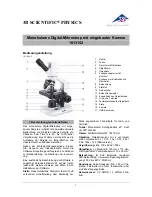
Sample Preparation
.
81
Special Cells
For discussion of the diamond anvil cell, see
Compression Cell
The compression cell (N187 0185, Figure 16) is a device for flattening soft materials
and holding specimens flat and in optical contact with salt windows. The cell
consists of an aluminum block, machined to accept salt windows, with window
retainers and a special wrench to apply pressure across the windows. The sample is
held between the two windows. The compression cell fits into the sample slide
holder on the stage of the microscope. 1 mm and 2 mm thick windows of 13 mm
outer diameter can be used with the cell; two KBr windows (2 mm thickness) are
included. The cell can apply pressure without rotating the windows, and therefore
avoids scratching them.
Figure 16 The Compression Cell
Although thinning can be accomplished with the compression cell, it does not
replace the miniature diamond anvil cell as a sample-thinning device. The primary
application of the compression cell is for keeping specimens flat over the entire
visual field of view. The sample area to be isolated is then more accurately
determined and apertured, and you do not have to refocus the microscope when
viewing different parts of the sample.
Summary of Contents for MultiScope System
Page 1: ...MultiScope System Microscope User s Reference ...
Page 5: ...Introduction ...
Page 14: ...14 MultiScope System Microscope User s Reference ...
Page 15: ...Warnings and Safety Information ...
Page 31: ...Overview of the MultiScope System Microscope ...
Page 44: ...44 MultiScope System Microscope User s Reference ...
Page 45: ...Getting Ready to Use the Microscope ...
Page 53: ...Tutorial Using the Microscope ...
Page 63: ...Preparing Samples ...
Page 83: ...Collecting Spectra with the Microscope ...
Page 95: ...Operating the Optional Equipment ...
Page 109: ...Applications ...
Page 122: ...122 MultiScope System Microscope User s Reference ...
Page 123: ...Maintenance ...
















































